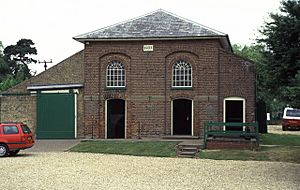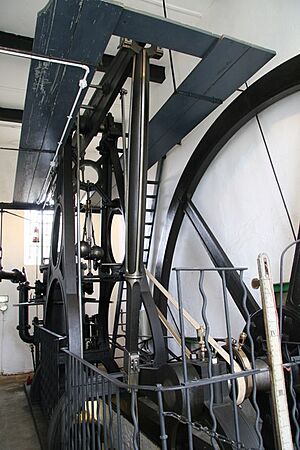Pinchbeck Engine facts for kids
Quick facts for kids Pinchbeck Engine |
|
|---|---|

The engine house
|
|
| Type | Beam engine |
| OS grid reference | TF 26174 26148 |
| Built | 1833 |
| Owner | Welland and Deepings Internal Drainage Board |
| Official name: Pinchbeck engine | |
| Reference no. | 1004966 |
|
Listed Building – Grade II
|
|
| Official name: Pinchbeck Engine Drainage Pump | |
| Designated | 13 January 1988 |
| Reference no. | 1146782 |
| Lua error in Module:Location_map at line 420: attempt to index field 'wikibase' (a nil value). | |
The Pinchbeck Engine is a very old and important machine. It is a special type of steam engine called a beam engine. This engine was built way back in 1833. Its main job was to pump water away from a wet area called Pinchbeck Marsh. This marsh is located near Spalding in Lincolnshire, England. The engine worked for many years, helping to keep the land dry. It pumped water into a channel called the Blue Gowt. This channel then joined the River Glen at Surfleet Seas End.
Contents
The Pinchbeck Engine Museum
In 1952, the Pinchbeck Engine stopped working. Newer electric pumps could do the job better. For a while, the old engine was forgotten. But then, in 1979, it was opened to the public as a museum!
What You Can See at the Museum
The museum is a great place to learn about how land was drained in the past. The old coal storage area is now a museum. It is called the Museum of Land Drainage. You can also see the blacksmith's shop. It looks just like it did when the engine was working. The Welland and Deepings Internal Drainage Board runs the museum. This group is in charge of managing water in the area today. The buildings where the engine is kept are very old and important. They are listed as Grade II buildings and also as a Scheduled Ancient Monument. This means they are protected because of their history.
How the Engine Works Today
When the engine stopped working in 1952, its tall chimney was taken down. Also, the boiler, which made the steam, was not kept in good condition. So, the engine cannot make its own steam anymore. Today, the Pinchbeck Engine is a "static exhibit." This means it doesn't run on its own steam. However, an electric motor can turn parts of the engine. This allows visitors to see how it moved and worked.
How the Beam Engine Worked
The Pinchbeck Engine is a powerful machine. It is a 20 horsepower (15 kW) condensing steam engine. It has a large overhead beam that moves up and down. This beam is held up by a strong 'A'-shaped frame. The famous Butterley Company built this engine in Ripley, Derbyshire. It has one large cylinder. This cylinder is 35 inches (89 cm) wide and its piston moves 56 inches (1.42 m) up and down. The engine also has a huge flywheel. This wheel is 18 feet 6 inches (5.64 m) across! The engine could spin at up to 30 times per minute.
Pumping Water with the Scoop Wheel
The engine was connected by gears to a giant scoop wheel. This wheel was in a room next to the engine. The scoop wheel had 40 paddles around its edge. It was 22-foot (6.71 m) wide. This wheel could lift a huge amount of water. It could move up to 7,500 imperial gallons (34,000 L) of water every minute! It lifted the water about 8-foot (2.44 m) high. Each year, the engine lifted between 1,093,000 long tons (1,111,000 t) and 3,690,000 long tons (3,749,000 t) tons of water. The engine usually ran for about 180 days each year. An engine man lived on site and worked there all the time.
The Boiler and Coal Supply
The boiler that made the steam for the engine was built in 1895. It was a Lancashire boiler with two furnaces. It produced steam at 12 psi (83 kPa) pressure. The engine used about 1 cwt (51 kg) of coal every hour. At first, coal was brought to the engine by boats on canals. Later, a railway line was built from Spalding to Boston. Coal could then be delivered to a nearby station. From there, it was moved on a very short narrow gauge railway line. Small carts, like those used in coal mines, carried the coal. People pushed these carts by hand. One of these carts and a small piece of the railway track are on display at the museum.
Historical Importance
The Pinchbeck Engine is very special. People say it is the oldest 'A'-frame engine that is still in its original place. It also worked for the longest time as a beam engine in the Fens area. And it was the very last beam engine to be used there.
More Places to Explore
- Pode Hole where the Welland and Deeping IDB have another museum.
- Dogdyke Pumping Station
- Stretham Old Engine


